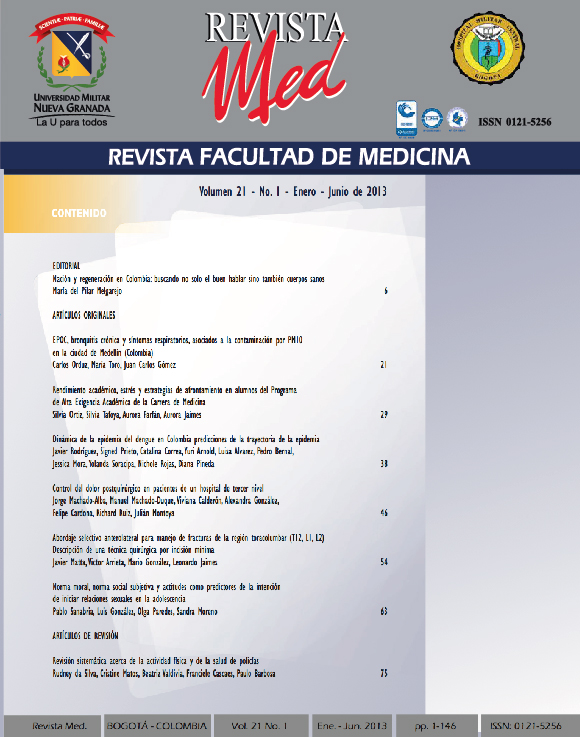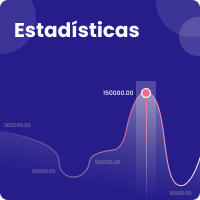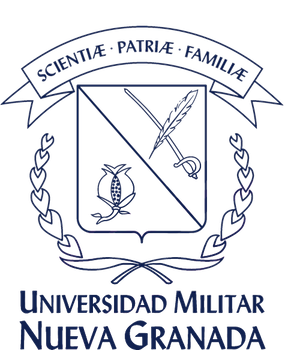Aplicaciones médicas de las células pluripotentes inducidas paciente-específicas
Resumen
Los recientes avances en la implementación de estrategias de reprogramación genética en células somáticas para la producción de células pluripotentes inducidas (iPS), abren la posibilidad de generar células pluripotentes para estudios del desarrollo embrionario y la diferenciación celular, herramientas para detección in vitro de nuevos medicamentos y evaluación de su eficacia y toxicidad, desarrollo de modelos in vitro de enfermedades humanas y uso en terapia celular. Las iPS, son células que muestran características fenotípicas y funcionales similares a las observadas en células madre embrionarias, sin los cuestionamientos éticos y legales de la manipulación de embriones. En articular, la generación de las células pluripotentes inducidas paciente-específicas ha permitido dilucidar los procesos fisiopatológicos de diversas enfermedades genéticas de etiología conocida y desconocida, así como plantean la posibilidad de realizar terapia celular autóloga y terapia génica basada en células para la regeneración tisular dependiendo de las necesidades individuales.
Descargas
Lenguajes:
esAgencias de apoyo:
A la Vicerrectoría de Investigaciones de la Universidad Militar Nueva Granada por la financiación del proyecto Med573Referencias bibliográficas
Gurdon JB, Byrne JA, Simonsson S. Nuclear reprogramming and stem cell creation. Proc Natl Acad Sci U S A. 003; 100(1):11819-22.
Takahashi K, Yamanaka S. Induction of pluripotent stem cells from mouse embryonic and adult fibroblast cultures by defined factors. Cell. 2006; 126(4): 663-76.
Nishikawa S, Goldstein RA, Nierras CR. The promise of human induced pluripotent stem cells for research and therapy. Nat Rev Mol Cell Biol. 2008; 9(9): 725-9.
Hall PA, Watt FM. Stem cells: the generation and maintenance of cellular diversity. Development. 1989; 106(4): 619-33.
Thomson JA, Itskovitz-Eldor J, Shapiro SS, Waknitz MA, Swiergiel JJ, Marshall VS, et al. Embryonic stem cell lines derived from human blastocysts. Science. 1998; 282(5391): 1145-7.
Potten CS, Loeffler M. Stem cells: attributes, cycles, spirals, pitfalls and uncertainties. Lessons for and from the crypt. Development.1990; 110(4): 1001-20.
Beltrán O, Quintero L, Chaparro O. Plasticidad y transdiferenciación en células “stem” adultas – Revisión. Revista Med.2005; 13(1): 10-16.
Smith A. A glossary for stem-cell biology. Nature. 2006; (441): 1060.
Gurdon JB. Adult frogs derived from the nuclei of single somatic cells. Dev Biol. 1962; 4: 256-73.
Campbell KH, McWhir J, Ritchie WA, Wilmut I. Sheep cloned by nuclear transfer from a cultured cell line. Nature. 1996;380(6569): 64-6.
Tada M, Tada T, Lefebvre L, Barton SC, Surani MA. Embryonic germ cells induce epigenetic reprogramming of somatic nucleus in hybrid cells. EMBO J. 1997; 16(21): 6510-20.
Tada M, Takahama Y, Abe K, Nakatsuji N, Tada T. Nuclear reprogramming of somatic cells by in vitro hybridization with ES cells. Curr Biol. 2001; 11(19): 1553-8.
Cowan CA, Atienza J, Melton DA, Eggan K. Nuclear reprogramming of somatic cells after fusion with human embryonic stem cells. Science. 2005; 309(5739): 1369-73.
Qin M, Tai G, Collas P, Polak JM, Bishop AE. Cell extractderived differentiation of embryonic stem cells. Stem Cells.2005; 23(6): 712-8.
Taranger CK, Noer A, Sørensen AL, Håkelien AM, Boquest AC, Collas P. Induction of dedifferentiation, genomewide transcriptional programming, and epigenetic reprogramming by extracts of carcinoma and embryonic stem cells. Mol Biol Cell.2005; 16(12): 5719-35
Tada T, Tada M. Toti-/pluripotential stem cells and epigenetic modifications. Cell Struct Funct. 2001; 26(3): 149-60.
Wilmut I, Beaujean N, de Sousa PA, Dinnyes A, King TJ, Paterson LA, Wells DN, Young LE. Somatic cell nuclear transfer. Nature.2002; 419(6907): 583-6.
Gurdon JB, Byrne JA. The first half-century of nuclear transplantation.Proc Natl Acad Sci U S A. 2003; 100(14): 8048-52.
Hochedlinger K, Jaenisch R. Nuclear reprogramming and pluripotency. Nature. 2006; 441(7097): 1061-7.
Mitalipov S, Wolf D. Totipotency, pluripotency and nuclear reprogramming.Adv Biochem Eng Biotechnol. 2009; 114:185-99.
Byrne JA, Simonsson S, Western PS, Gurdon JB. Nuclei of adult mammalian somatic cells are directly reprogrammed to oct-4 stem cell gene expression by amphibian oocytes. CurrBiol. 2003; 13(14): 1206-13.
Simonsson S, Gurdon J. DNA demethylation is necessary for the epigenetic reprogramming of somatic cell nuclei. Nat Cell Biol. 2004; 6(10): 984-90
Hajkova P, Ancelin K, Waldmann T, Lacoste N, Lange UC, Cesari F, et al. Chromatin dynamics during epigenetic reprogramming in the mouse germ line. Nature. 2008; 452(7189): 877-81.
Takahashi K, Tanabe K, Ohnuki M, Narita M, Ichisaka T, Tomoda K, et al. Induction of pluripotent stem cells from adult human fibroblasts by defined factors. Cell. 2007; 131(5): 861-72.
Yamanaka S. Strategies and new developments in the generation of patient-specific pluripotent stem cells. Cell Stem Cell.2007; 1(1): 39-49
Yu J, Vodyanik MA, Smuga-Otto K, Antosiewicz-Bourget J, Frane JL, Tian S, et al. Induced pluripotent stem cell lines derived from human somatic cells. Science. 2007; 318(5858): 1917-20.
Takahashi K, Okita K, Nakagawa M, Yamanaka S. Induction of pluripotent stem cells from fibroblast cultures. Nat Protoc.2007; 2(12): 3081-9.
Okita K, Nakagawa M, Hyenjong H, Ichisaka T, Yamanaka S.Generation of mouse induced pluripotent stem cells withoutviral vectors. Science. 2008; 322(5903): 949-53.
Nakagawa M, Koyanagi M, Tanabe K, Takahashi K, Ichisaka T, Aoi T, Okita K, et al. Generation of induced pluripotent stem cells without Myc from mouse and human fibroblasts. NatBiotechnol. 2008; 26(1): 101-6.
Maherali N, Hochedlinger K. Guidelines and techniques for the generation of induced pluripotent stem cells. Cell Stem Cell.2008; 3(6): 595-605.
Stadtfeld M, Nagaya M, Utikal J, Weir G, Hochedlinger K. Induced pluripotent stem cells generated without viral integration.Science. 2008; 322(5903): 945-9.
Kaji K, Norrby K, Paca A, Mileikovsky M, Mohseni P, Woltjen K. Virus-free induction of pluripotency and subsequent excision of reprogramming factors. Nature. 2009; 458(7239): 771-5
Kim D, Kim CH, Moon JI, Chung YG, Chang MY, Han BS,et al. Generation of human induced pluripotent stem cells bydirect delivery of reprogramming proteins. Cell stem cell. 2009;4(6): 472-6.
González F, Boué S, Izpisúa Belmonte JC. Methods for making induced pluripotent stem cells: reprogramming à la carte. Nat Rev Genet. 2011; 12(4): 231-42.
Hanna J, Markoulaki S, Schorderet P, Carey BW, Beard C, Wernig M, et al. Direct reprogramming of terminally differentiated mature B lymphocytes to pluripotency. Cell. 2008; 133(2):250-64. Erratum in: Cell. 2008; 134(2):365.
Müller R, Lengerke C. Patient-specific pluripotent stem cells: promises and challenges. Nat Rev Endocrinol. 2009; 5(4): 195-203.
Ensenat-Waser R, Pellicer A, Simon C. Reprogrammed induced pluripotent stem cells: how suitable could they be in reproductive medicine? Fertil Steril. 2009; 91(4): 971-4.
Zhu H, Lensch MW, Cahan P, Daley GQ. Investigating monogenic and complex diseases with pluripotent stem cells. Nat Rev Genet. 2011; 12(4): 266-75.
Robinton DA, Daley GQ. The promise of induced pluripotent stem cells in research and therapy. Nature. 2012; 481(7381):295-305.
Soldner F, Jaenisch R. Medicine. iPSC disease modeling. Science.2012; 338(6111): 1155-6.
Park IH, Arora N, Huo H, Maherali N, Ahfeldt T, Shimamura A, et al. Disease-specific induced pluripotent stem cells. Cell.2008; 134(5): 877-86.
Park IH, Lerou PH, Zhao R, Huo H, Daley GQ. Generation of human-induced pluripotent stem cells. Nat Protoc. 2008;3(7): 1180-6.
Mou X, Wu Y, Cao H, Meng Q, Wang Q, Sun C, et al. Generation of disease-specific induced pluripotent stem cells from patients with different karyotypes of Down syndrome. Stem Cell Res Ther. 2012; 3(2): 14.
Maclean GA, Menne TF, Guo G, Sanchez DJ, Park IH, Daley GQ, Orkin SH. Altered hematopoiesis in trisomy 21 as revealed through in vitro differentiation of isogenic human pluripotent cells. Proc Natl Acad Sci USA. 2012; 109(43): 17567-72.
Li LB, Chang KH, Wang PR, Hirata RK, Papayannopoulou T, Russell DW. Trisomy correction in Down syndrome induced pluripotent stem cells. Cell Stem Cell. 2012; 11(5): 615-9.
Jang J, Yoo JE, Lee JA, Lee DR, Kim JY, Huh YJ, et al. Diseasespecific induced pluripotent stem cells: a platform for human disease modeling and drug discovery. Exp Mol Med. 2012;44(3): 202-13.
Pfannkuche K, Hannes T, Khalil M, Noghabi MS, MorshediA, Hescheler J, et al. Induced pluripotent stem cells: a new approach for physiological research. Cell Physiol Biochem.2010; 26(2): 105-24.
Unternaehrer JJ, Daley GQ. Induced pluripotent stem cells for modelling human diseases. Philos Trans R Soc Lond B Biol Sci.2011; 366(1575): 2274-85.
Lee G, Papapetrou EP, Kim H, Chambers SM, Tomishima MJ, Fasano CA, et al. Modelling pathogenesis and treatment of familial dysautonomia using patient-specific iPSCs. Nature.2009; 461(7262):402-6.
Lee G, Studer L. Modelling familial dysautonomia in human induced pluripotent stem cells. Philos Trans R Soc Lond B Biol Sci. 2011; 366(1575): 2286-96.
Crawford TO, Pardo CA. The neurobiology of childhood spinal muscular atrophy. Neurobiol Dis. 1996; 3(2): 97-110.
Xiao J, Marugan JJ, Zheng W, Titus S, Southall N, Cherry JJ,et al. Discovery, synthesis, and biological evaluation of novel SMN protein modulators. J Med Chem. 2011; 54(18): 6215-33.
Lorson CL, Hahnen E, Androphy EJ, Wirth B. A single nucleotide in the SMN gene regulates splicing and is responsible for spinal muscular atrophy. Proc Natl Acad Sci USA. 1999; 96(11):6307-11.
Schmid A, DiDonato CJ. Animal models of spinal muscular atrophy. J Child Neurol. 2007; 22(8): 1004-12.
Kostova FV, Williams VC, Heemskerk J, Iannaccone S, Didonato C, Swoboda K, et al. Spinal muscular atrophy: classification,diagnosis, management, pathogenesis, and future research directions. J Child Neurol. 2007; 22(8): 926-45.
Ebert AD, Yu J, Rose FF Jr, Mattis VB, Lorson CL, Thomson JA, et al. Induced pluripotent stem cells from a spinal muscular atrophy patient. Nature. 2009; 457(7227): 277-80.
Kemp S, Pujol A, Waterham HR, van Geel BM, Boehm CD, Raymond GV, et al. ABCD1 mutations and the X-linked adrenoleukodystrophy mutation database: role in diagnosis and clinical correlations. Hum Mutat. 2001; 18(6): 499-515.
Jang J, Kang HC, Kim HS, Kim JY, Huh YJ, Kim DS, et al.Induced pluripotent stem cell models from X-linked adrenoleukodystrophy patients. Ann Neurol. 2011; 70(3): 402-9.
Wang XM, Yik WY, Zhang P, Lu W, Dranchak PK, Shibata D, et al. The gene expression profiles of induced pluripotent stem cells from individuals with childhood cerebral adrenoleukodystrophy are consistent with proposed mechanisms of pathogenesis. Stem Cell Res Ther. 2012; 3(5): 39.
Agarwal S, Loh YH, McLoughlin EM, Huang J, Park IH, Miller JD, et al. Telomere elongation in induced pluripotent stem cells from dyskeratosis congenita patients. Nature. 2010; 464(7286): 292-6.
Batista LF, Pech MF, Zhong FL, Nguyen HN, Xie KT, Zaug AJ,et al. Telomere shortening and loss of self-renewal in dyskeratosis congenita induced pluripotent stem cells. Nature. 2011;474(7351): 399-402.
Dean JC. Marfan syndrome: clinical diagnosis and management.Eur J Hum Genet. 2007; 15(7): 724-33.
Aalberts JJ, Thio CH, Schuurman AG, van Langen IM, van der Pol BA, van Tintelen JP, van den Berg MP. Diagnostic yield in adults screened at the Marfan outpatient clinic using the 1996 and 2010 Ghent nosologies. Am J Med Genet A. 2012;158A(5): 982-8.
Quarto N, Leonard B, Li S, Marchand M, Anderson E, Behr B, et al. Skeletogenic phenotype of human Marfan embryonic stem cells faithfully phenocopied by patient-specific induced-pluripotent stem cells. Proc Natl Acad Sci USA. 2012; 109(1): 215-20.
Dimos JT, Rodolfa KT, Niakan KK, Weisenthal LM, Mitsumoto H, Chung W, et al. Induced pluripotent stem cells generated from patients with ALS can be differentiated into motor neurons.Science. 2008; 321(5893): 1218-21.
Ming GL, Brüstle O, Muotri A, Studer L, Wernig M, Christian KM. Cellular reprogramming: recent advances in modeling neurological diseases. J Neurosci. 2011; 31(45): 16070-5.
Juopperi TA, Kim WR, Chiang CH, Yu H, Margolis RL, Ross CA, et al. Astrocytes generated from patient induced pluripotent stem cells recapitulate features of Huntington’s disease patient cells. Mol Brain. 2012; 5: 17.
Walker FO. Huntington’s disease. Lancet. 2007; 369(9557): 218-28.
Chae JI, Kim DW, Lee N, Jeon YJ, Jeon I, Kwon J, et al. Quantitative proteomic analysis of induced pluripotent stem cells derived from a human Huntington’s disease patient. Biochem J. 2012; 446(3): 359-71.
Saha K, Jaenisch R. Technical challenges in using human induced pluripotent stem cells to model disease. Cell Stem Cell.2009; 5(6): 584-95.
Hanna JH, Saha K, Jaenisch R. Pluripotency and cellular reprogramming:facts, hypotheses, unresolved issues. Cell. 2010;143(4): 508-25.
Jaenisch R, Young R. Stem cells, the molecular circuitry of pluripotency and nuclear reprogramming. Cell. 2008; 132(4): 567-82.
Hochedlinger K, Plath K. Epigenetic reprogramming and induced pluripotency. Development. 2009; 136(4): 509-23.
Kim K, Doi A, Wen B, Ng K, Zhao R, Cahan P, et al. Epigenetic memory in induced pluripotent stem cells. Nature. 2010;467(7313): 285-90.
Sun N, Longaker MT, Wu JC. Human iPS cell-based therapy: considerations before clinical applications. Cell Cycle. 2010; 9(5): 880-5.
Chun YS, Byun K, Lee B. Induced pluripotent stem cells and personalized medicine: current progress and future perspectives.Anat Cell Biol. 2011; 44(4): 245-55.
Hanna J, Wernig M, Markoulaki S, Sun CW, Meissner A, Cassady JP, et al. Treatment of sickle cell anemia mouse model with iPS cells generated from autologous skin. Science. 2007;318: 1920-1923.
Xu D, Alipio Z, Fink LM, Adcock DM, Yang J, Ward DC, et al.Phenotypic correction of murine hemophilia A using an iPS cellbased therapy. Proc Natl Acad Sci USA. 2009; 106: 808-813.
Wernig M, Zhao JP, Pruszak J, Hedlund E, Fu D, Soldner F, et al. Neurons derived from reprogrammed fibroblasts functionally integrate into the fetal brain and improve symptoms of rats with Parkinson’s disease. Proc Natl Acad Sci USA. 2008;105: 5856-5861.
Raya A, Rodríguez-Pizà I, Guenechea G, Vassena R, Navarro S, Barrero MJ, et al. Disease-corrected haematopoietic progenitors from Fanconi anaemia induced pluripotent stem cells. Nature.2009; 460(7251): 53-9.
Müller LU, Milsom MD, Harris CE, Vyas R, Brumme KM, Parmar K, et al. Overcoming reprogramming resistance of Fanconi anemia cells. Blood. 2012; 119(23): 5449-57.
Tolar J, Park IH, Xia L, Lees CJ, Peacock B, Webber B, et al. Hematopoietic differentiation of induced pluripotent stem cells from patients with mucopolysaccharidosis type I (Hurler syndrome). Blood. 2011; 117(3): 839-47.
Singh R, Shen W, Kuai D, Martin JM, Guo X, Smith MA, et al.iPS cell modeling of Best disease: insights into the pathophysiology of an inherited macular degeneration. Hum Mol Genet.2012 Nov 12. [Epub ahead of print]
Bilican B, Serio A, Barmada SJ, Nishimura AL, Sullivan GJ,Carrasco M, et al. Mutant induced pluripotent stem cell lines recapitulate aspects of TDP-43 proteinopathies and reveal cell-specific vulnerability. Proc Natl Acad Sci U S A. 2012;109(15): 5803-8.
Rowntree RK, McNeish JD. Induced pluripotent stem cells: opportunities as research and development tools in 21st century drug discovery. Regen Med. 2010; 5(4): 557-68.
Deshmukh RS, Kovács KA, Dinnyés A. Drug discovery models and toxicity testing using embryonic and induced pluripotent stem-cell-derived cardiac and neuronal cells. Stem Cells Int.2012; 379569. Epub 2012 May 8.
Lengerke C, Grauer M, Niebuhr NI, Riedt T, Kanz L, Park IH,Daley GQ. Hematopoietic development from human induced pluripotent stem cells. Ann N Y Acad Sci. 2009; 1176: 219-27.
Peters A, Burridge PW, Pryzhkova MV, Levine MA, Park TS,Roxbury C, et al. Challenges and strategies for generating therapeutic patient-specific hemangioblasts and hematopoietic stem cells from human pluripotent stem cells. Int J Dev Biol.2010; 54(6-7): 965-90.
Pessach IM, Ordovas-Montanes J, Zhang SY, Casanova JL,Giliani S, Gennery AR, et al. Induced pluripotent stem cells: a novel frontier in the study of human primary immunodeficiencies.J Allergy Clin Immunol. 2011; 127(6): 1400-7.
Spits C, Mateizel I, Geens M, Mertzanidou A, Staessen C, Vandeskelde Y, et al. Recurrent chromosomal abnormalities in human embryonic stem cells. Nature Biotechnology. 2008; 26:1361-1363.







.png)





